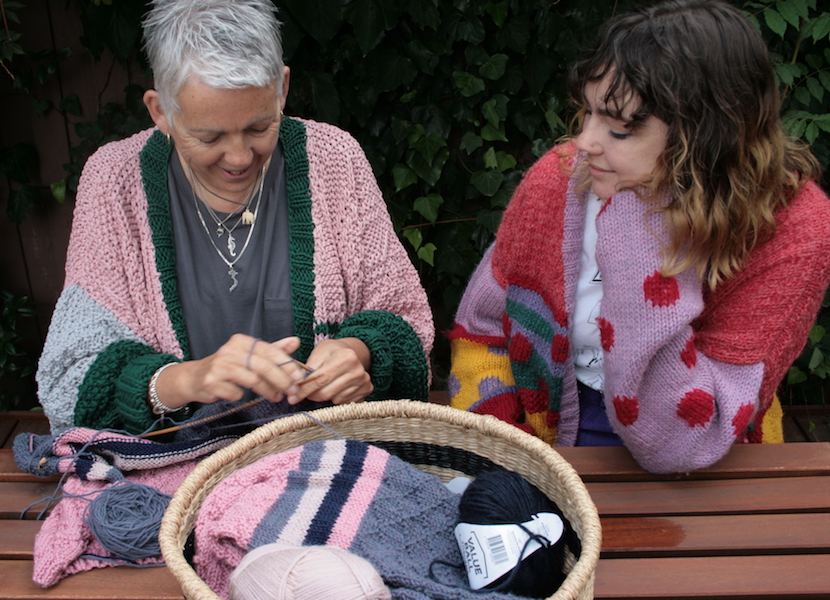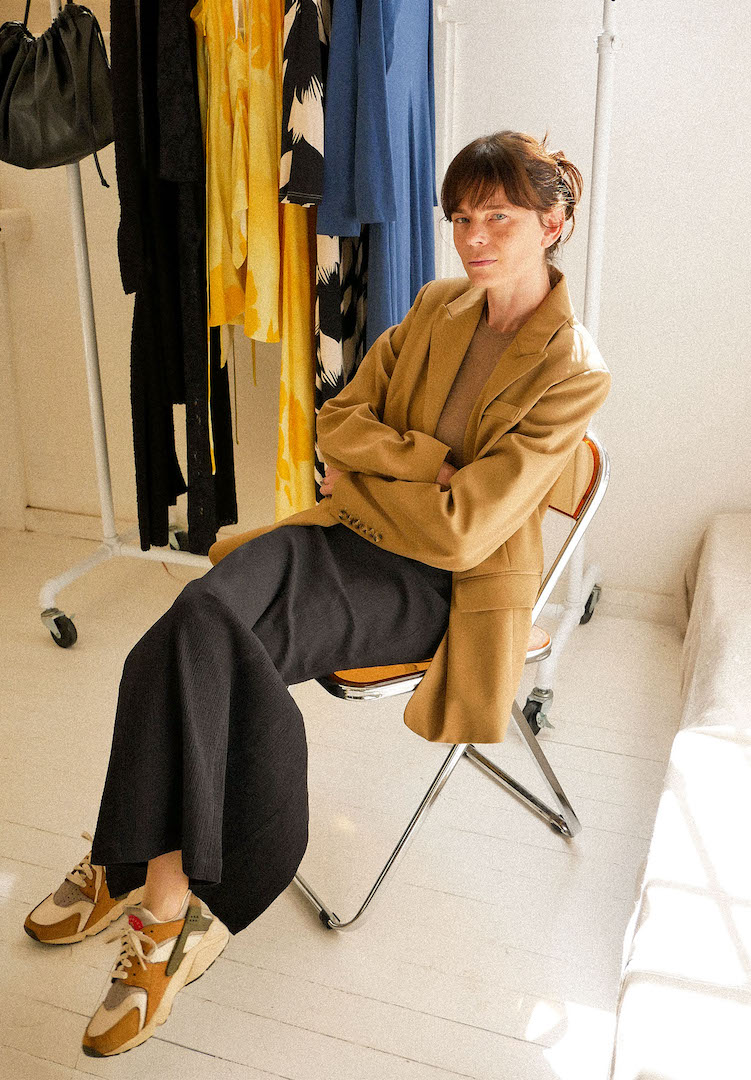An interview with my Mum, the incredible talent behind Loris
WORDS BY MAEVE KERR-CROWLEY
The woman who taught me almost everything I know.
I learnt most of what I know about fashion from my mum.
She taught me the value of an outfit you feel comfortable and interesting in, and the importance of colour coordination. She taught me how to op shop like a professional, as well as how to sew.
When she taught me all these things, she was just my mum. She’d never dipped her toes into the fashion industry, instead working throughout her life as a mother, a nanny, a Subway sandwich artist and a carer for my elderly grandparents.
And while I think my siblings and I all turned out as well as can be hoped, that was a period where some of her most impressive skills were going unappreciated. My mum is a knitter, and she’s really, really good. She’s super fast and very creative, and has a killer eye for colour.
So in 2016, at an age she insists classifies her as an “old broad”, she started her own label.
Named Loris (after my grandmother), the label specialises in psychedelically colourful, one-of-a-kind knitwear. Her business model is just as unique as these jumpers, with every single stitch knitted by her own two skilled hands.
While watching Loris grow from an idea at a birthday dinner to an admittedly niche but successful venture – it’s now stocked in multiple states, was featured in a runway at VAMFF last year, and a Loris x Kuwaii collaboration dropped only recently – I’ve learnt a lot about what it takes to navigate the ever-changing fashion industry.
Mums tend to specialise in sharing helpful, inspiring wisdom without sugar-coating the essentials. So, between coffee and a trip to the op shop, I sat down with Lisa Kerr from Loris to see if she had any gems to share from her own journey.
Hi, Mum.
Hi, Maeve.
First of all, introduce yourself.
I’m Lisa. I’m the knitter for Loris. I’m old, I have four children, a dog and a chicken, and I live in Ballarat.
You’ve been knitting for a super long time. Tell everybody about how you learnt.
My mother taught me to knit. Her name was Loris, hence the name of the business, and she was a beautiful knitter. In that era, knitting was done mostly out of necessity. A lot of garments knitted in our house were made of older garments that had been worn and handed down and pulled apart. Fabric and yarn weren’t really things you went and purchased back then. I started knitting doll clothes because I was obsessed with dolls and Barbie, and I sewed a lot of clothes from other garments, too.
When you had us, were you planning on passing those skills down like your mum did?
I always hoped that at least one of my kids would be interested in craft of some description. I’m very pleased to say that was you, and you took to it like a duck to water. But when I think about your approach to crafting, your tolerance and patience outweigh mine a million fold. Especially with sewing, if any mistakes were made, I used to be that awful person that would just throw it in the bin or take it to the op shop and hope someone would finish it. Whereas you had the patience of Job and would always pull it out, start again.
If you have no patience, how do you spend 30 to 50 hours on each jumper?
Well, I don’t make mistakes, most of the time. Knitting is much more relaxing because you can sit on the couch with your slippies on, a cup of tea, a good British crime show and the dog, and just knit for hours. I might drop a stitch or two here and there and have to pull it back, but that’s probably the worst of it.
When you decided to make Loris a reality, did you have any reservations about starting your own business?
My only reservation was how I would get it out to the people. Being of an older vintage, social media obviously wasn’t around when I was your age. It’s an amazing platform for anyone that wants to get their work out there, but you still need certain people to notice you for it to get wings and become something. You’ve got to get someone to buy it. My biggest reservation was how I would do that. Because I’d just been a mum and a carer for so many years, I didn’t know those sorts of people.
What other things have you had to learn along the way?
I’m still not very good with the business side of it and the money side of it, and the behind the scenes stuff like social media and photography. I find that really challenging, because that wasn’t around when I went to school. It was all still pen and paper. I still write down all my patterns, and I handwrite how many stitches are in each garment. My son’s always banging on about doing spreadsheets and stuff, but it’s just not me. I don’t understand it.
Do you think it’s changed the experience, getting into fashion later in life than most people might?
Absolutely. I think, being older, there’s a reservation that maybe you are a bit old to be doing this. Everyone that I’ve come in contact with, as Loris has grown, is very young and cool and hip, and I’m not. But when you’re actually in the thick of it, it really doesn’t seem to matter because that younger set is appreciating the clothes the most. I’ve got kids saying, “It’s so cool to have hand-knitted garments”, where for many, many years, it was considered very uncool. But I still find it challenging that I’m older than other fashion people. Not so much sitting at home knitting, because I can do that in my jammies, but at VAMFF last year and events in Adelaide with one of my new stockists, I was just thinking, “Am I going to say the right thing? Am I going to look okay? Am I going to know what anyone’s talking about?” So, it’s nice when the people don’t actually care, and they’re just talking about the garments and how much they love them and how clever I am.
Tell everyone a bit about your creative process.
It starts with a colour palette, which usually comes from something I’ve seen, like a print. On social media, I follow a lot of artists who put up their work and sometimes something will just pop out. Then it’s thrown lovingly into a basket. Not a lot of pre-thinking goes into what’s going to happen next or what colour’s going to go where, which is fun. Every now and then, I have to pull something out because it doesn’t work, or a stripe would look better somewhere else, or whatever. But a lot of it is in the moment.
Why did you decide to make such colourful pieces?
I love colour. It’s not in my wardrobe, but colour is amazing and fun and it should be out there. People talk about colours being relevant or out of style and that kind of thing, but colour really is just colour. It’s also fun when you look at colours and think that really shouldn’t go with that, but then it works so well in a jumper or a cardigan. I always dressed you kids in a lot of colour, but with the Loris garments, I work with colours that I would never in a million years have put together on you. There was always so much thought put into everything matching. But as I’ve gotten older, I’ve realised that colour can be so experimental.
I always thought it was weird that you never wear colour yourself, considering how colourful our wardrobes were as kids. That’s definitely followed me into my adult life.
It’s not that I don’t feel comfortable in it, necessarily. It’s probably because, being taller and a little bit bigger, I always dress to cover a multitude of sins. And, in my head, colour doesn’t do that.
I mean we’re about the same height, same size, and I’ve definitely thought that before. If you already stand out so much, should you be wearing less colour and hiding a little more? But that just seems kind of boring and dumb.
It is. It is boring and dumb. And I wish I’d been a little more courageous with colour throughout my life. You know, you see older women with blue hair wearing these amazing coloured clothes and think, “Oh, I wish I was that brave”.
So, with the colour palettes and the knitting, you do everything yourself from start to finish. Is it hard being a one-woman team?
It is, because there’s no rest for the wicked. There’s no taking a couple of days off and just hanging out because there’s always a collection, or a collaboration, or stockists wanting things, or custom orders. And it is literally just me. People say to me, “You’ll have to employ knitters,” but that’s almost impossible. I can’t pass that work on to somebody and say, here’s a basket, go knit this. Because I don’t even know what I’m going to do with that basket of yarn. I get a lot of support from you kids and family and friends, but they can’t help me knit anything. And I’ve wracked my brain about how we can get around that, but then you lose the essence of Loris – that every single stitch is knitted by me in my lounge room. But I figure that if you want one bad enough, then you’ll happily wait for me to get around to it.
What’s it been like collaborating with Kuwaii?
It’s been very exciting and humbling. It goes back to what I said before, worrying about people going, “You’re just an old broad, you really shouldn’t be doing this.” The fact that a company like Kuwaii approached me is very cool. Their garments are stunning, their colours are stunning, and the ethical and sustainable side of it is fantastic. They’ve been very generous by just saying, “These are the colours we want, off you go.” There’s been lots of new followers on Instagram, lots of new supporters, lots of new beautiful comments about the garments, which is really lovely.
You mentioned Kuwaii’s approach to sustainability. Do you consider what you do sustainable?
I hope so. I feel like anyone that purchases a Loris product really, really wants one. They’re willing to pay that amount of money, so they’ll love it and take care of it and hopefully hand it down. Like the knitted garments of my youth, it’ll be around for a long, long time, and I’d be happy for someone down the track to pull it apart and make something else with all those fabulous colours. But in the meantime, they get to enjoy it.
If you could see anybody in the world wearing a Loris piece, who would it be?
I follow Drew Barrymore on Instagram.
Oh, Drew Barrymore would totally get behind it.
She has her own range of clothes and things like that, and her Instagram is so colourful and fun. I often sit there and think I should just drop her an email or something. Maybe I will now.
Final question. For some motherly support, am I a good interviewer?
You’re a great interviewer. I’m always banging on about how good a wordsmith you are, so I’m hoping you’ll make me sound super intelligent. I think your approach to interviewing is great.
Thanks, Mum. I think your approach to knitting is great.


















